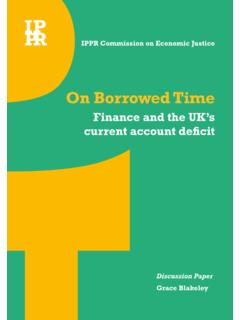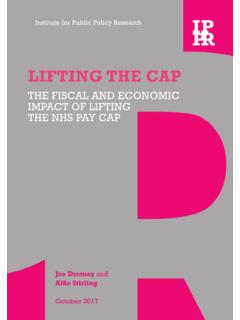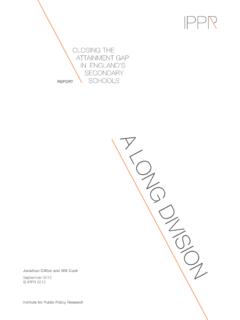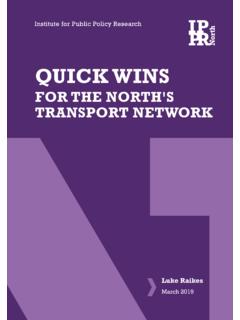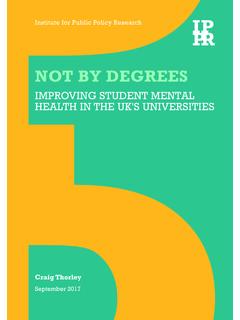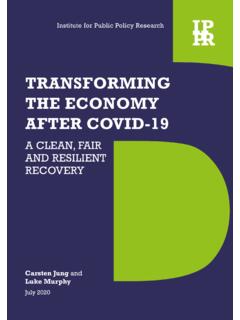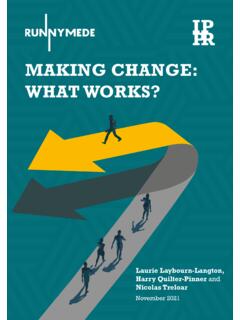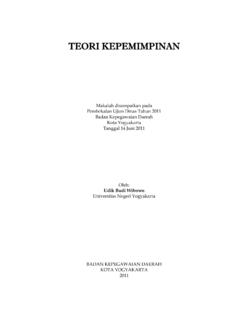Transcription of MAKING THE DIFFERENCE - IPPR
1 MAKING THE DIFFERENCEBREAKING THE LINK BETWEEN SCHOOL EXCLUSION AND SOCIAL EXCLUSIONK iran Gill, with Harry Quilter-Pinner and Danny SwiftOctober 2017 Institute for Public Policy ResearchABOUT IPPRIPPR, the Institute for Public Policy Research, is the UK s leading progressive think tank. We are an independent charitable organisation with our main offices in London. IPPR North, IPPR s dedicated think tank for the North of England, operates out of offices in Manchester and Newcastle, and IPPR Scotland, our dedicated think tank for Scotland, is based in purpose is to conduct and promote research into, and the education of the public in, the economic, social and political sciences, science and technology, the voluntary sector and social enterprise, public services, and industry and 14 Buckingham Street London WC2N 6DF T: +44 (0)20 7470 6100 E: Registered charity no: 800065 (England and Wales), SC046557 (Scotland)This report was first published in October 2017.
2 IPPR 2017 The contents and opinions expressed in this report are those of the authors progressive policy think tankIPPR | MAKING The DIFFERENCE Breaking the link between school exclusion and social exclusion1 DownloadThis document is available to download as a free PDF and in other formats at: you are using this document in your own writing, our preferred citation is:Gill K (2017) MAKING The DIFFERENCE : Breaking the link between school exclusion and social exclusion, IPPR. to shareThis document is published under a creative commons licence: Attribution-NonCommercial-NoDerivs UK For commercial use, please contact byIPPR | MAKING The DIFFERENCE Breaking the link between school exclusion and social exclusion2 CONTENTSP reface ..5 Key terms ..6 Summary ..760-second summary ..7 Key findings.
3 7 Recommendations ..8 Introduction ..91. What is exclusion and how many children does it affect? .. What is exclusion? .. How many children does exclusion affect? .. Conclusions ..152. Who gets excluded and why? .. The demographics of exclusion .. Complex needs .. Explaining the rise in exclusions .. What happens to excluded children and what is the cost to society? .. The social cost of exclusion .. The economic cost of exclusion .. Conclusions ..23 IPPR | MAKING The DIFFERENCE Breaking the link between school exclusion and social exclusion34. The role of schools .. Breaking the link between school exclusion and social exclusion .. Capacity to prevent exclusion .. Capacity to improve trajectories for excluded pupils .. Conclusions ..365. The right to a different story .. MAKING the DIFFERENCE .
4 Step 1: Recruit exceptional teachers into the AP sector .. Step 2: Upskill these teachers as multidisciplinary leaders .. Step 3: Develop a route back into leadership roles in the mainstream sector .. Conclusions and recommendations ..44 Annex I. Examples of types of alternative provision ..45 Annex II. Variation in exclusion by local authority ..47 References ..48 IPPR | MAKING The DIFFERENCE Breaking the link between school exclusion and social exclusion4 ABOUT THE AUTHORK iran Gill began her career in inner-city London, as a teacher and leader in schools serving the most deprived postcodes in the country. After five years on the frontline, Kiran left to work in education policy, searching for solutions to the rising number of vulnerable children who fall through the gaps. Kiran has been developing the idea for The DIFFERENCE , alongside a network of supporters, since Summer you to frontline practitioners, academics and experts who have helped inform this report and shape proposals for The DIFFERENCE , particularly those who warmly welcomed us into their schools: Jonty Clark and the team at Beckmead Family of Schools; Anna Cain and the team at The Boxing Academy; Chris Wright, Jane Reed, Graham Payne and the team at Catch 22; Wendy Casson and all her team at Education Diversity; Neil Dawson, Brenda McHugh, Stephen Taylor and the team at The Family School; Emma Bradshaw, Simon Barber and the team at The Limes College; Seamus Oates, Sarah Hardy and the team at TBAP multi academy trust.
5 Dave Whitaker, Mark Wilson, Amy Portier and the teams at Wellspring Trust, Springwell Lincolnshire and Springwell Learning Community; Sarah Evans, John Reilly and the team at Westside School; Steve Adcock, Maggie Atkinson, Kristine Black-Hawkins, Amy Ball, David Boyle, Laura Bradford, Richard Brown, Shaun Brown, Faye Crastor, Jake Curtis, Amy Devlin, Amy De Zoya, Rebecca Cox, Harry Daniels, Candida Dearing, Ruth Elborn, Tamsin Ford, Rachael Hare, Jason Howard, Hussein Hussein, Peter Gray, Sharon Gray, Mike Groves, Paul Kelly, Anita Kerwin-Nigh, Simon Knight, Rachel Knowles, Alison Kriel, Belinda Logan, Loic Menzies, Susan Morris-King, John Murphy, Jarlath O Brien, Laura Percival, Tamsin Poulter, Will Ross, Samira Sadeghi, Michelle Sault, Frankie Sharma, Andrew Smith, John Tomsett, Pat Thomson, Sam Twistleton, John Watkin, Sarah Wilson, Sarah Wild, Ed also to those who did not wish to be thanks to the steering group for this report.
6 Josh MacAlister, Mick Atkinson, Jonathan Clifton, Graeme Duncan, Sarah Evans, Jamie Feilden, Sam Freedman, Maria Neophytou and Craig you to all those who volunteered time and expertise in the preparation of this report including Harry Quilter-Pinner, Danny Swift, Sarah Waite, Vahe Boghosian, Craig Thorley, Sam Wood, Danton Bounds, Nick Rose, Nik Nicheperovich, Anna Taylor, Alicia Kenshole, Jessica Davies, George Saunders, Ryo Harada, Alex MacAleavey, Roshni Best, Alex Cheung, David Thomas, Tessa you to the friends of the project who have given time, insight, commented on drafts, given advice and support: Edward Timpson, Charlie Taylor, Philip Nye, Jonathan Clifton, Sam Freedman, Dave Whitaker, Brett Wigdortz, James Darley, Paul Dreschler, Natasha Porter, Ella Joseph, Alison Peacock, Matt Hood, Laura last, but not least, thank you to those whose investment made this work possible, particularly Stephen Carrick-Jones at The Inclusion Trust, who first took a chance and invested in this research.
7 Thank you to Impetus-PEF and Sarah Evans at the Oxford Youth Lab, who also supported us at the earliest stage. Thanks to Teach First, who awarded The DIFFERENCE its Innovation Award. Thank you to Catherine Hillis and Esm e Fairbairn Foundation, whose support enabled our YouGov survey and is helping The DIFFERENCE in the next stage of our journey. Thank you also to all those joining us as we work to bring The DIFFERENCE to life: Essie North and the team at Big Change; Jessamy Gould and the Treebeard Trust and Jake Hayman at Ten Years | MAKING The DIFFERENCE Breaking the link between school exclusion and social exclusion5 PREFACETHE BEST IN EDUCATION, FOR THOSE WHO NEED IT MOSTE dward Timpson, Former Minister of State for Vulnerable Children and Families, 2012-17 Growing up in a family who fostered taught me many things about the children we cared for.
8 I saw first-hand that the educational underperformance of children who are vulnerable those involved with the care system, poorer pupils and those with special needs is a complex and enduring challenge. Yet this is also where stakes are highest, and where successful innovations can truly change education to transform the life chances of vulnerable children, new solutions must be evidence-informed, ambitious and willing to evolve beyond a siloed system of public service is why I welcome this report, which calls for new expertise in the teaching workforce. The programme it outlines, The DIFFERENCE , seeks to raise the status of and evidence-base for teaching the most vulnerable learners, and to improve capacity for collaboration between schools and other agencies so troubled young people get the right support at the right time.
9 When in government, I ensured the targeting of funding at vulnerable children, and helped prioritise their admission to the best schools. The DIFFERENCE sets out how the best in teaching practice can be directed at the children who need it most. IPPR | MAKING The DIFFERENCE Breaking the link between school exclusion and social exclusion6 KEY TERMSTERMEXPLANATIONAPA lternative provision is a catch-all term which describes all educational provision outside of mainstream and special needs schools. It includes state maintained PRUs as well as independent and non-registered and Adolescent Mental Health Services, run by the in needChild interacting with social care services who does not meet the threshold for being 'looked-after' but who is nonetheless receiving intervention from social care services.
10 Child protection planA plan drawn up by social care services to protect a child who they feel is suffering, or is likely to suffer, significant professional development for teachers. EHCPE ducation, Health and Care Plan. details extra support required for a child with formally diagnosed special educational needs or disabilities (SEND). These replaced statements of special educational needs in school meals eligibility is a proxy for poverty in the UK: schools with higher proportions of FSM-eligibility serve more disadvantaged Local looked after child (also 'child in care') is a child who is living with foster parents; at home under social services supervision; or in residential homes or units formally under the care of the local government watchdog responsible for inspecting schools and other educational institutions.
